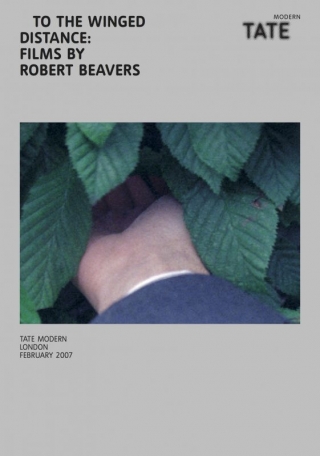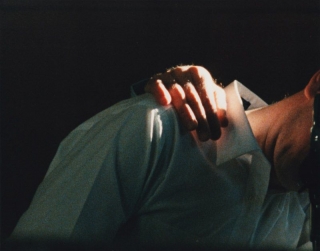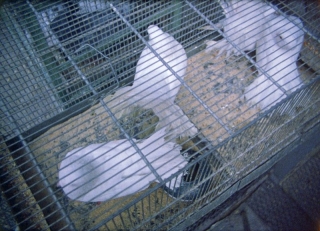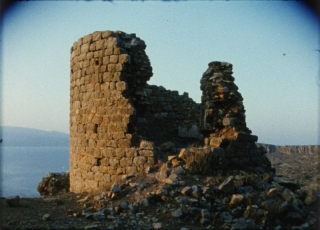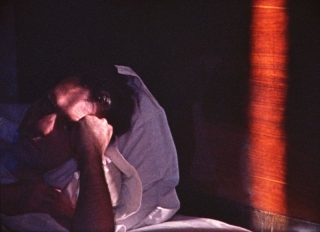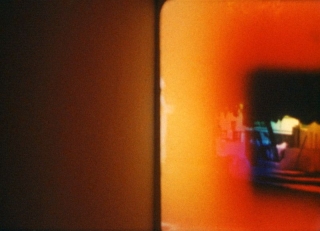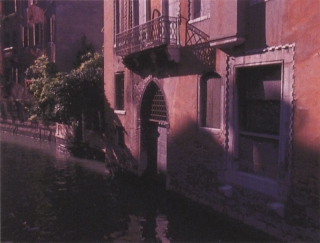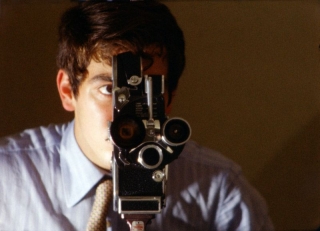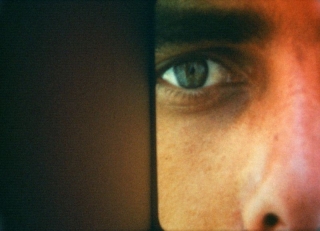Date: 2 February 2007 | Season: Robert Beavers 2007
TO THE WINGED DISTANCE: FILMS BY ROBERT BEAVERS
2—25 February 2007
London Tate Modern
Since leaving the USA in 1967, Robert Beavers has laboured in relative isolation on works whose goal “is for the projected film image to have the same force of awakening sight as any other great image.” His meticulously crafted films are at once lyrical and rigorous, sensuous and complex. Whilst communicating his response to the landscapes, architecture and traditions of the Mediterranean and Alpine countries in which they were filmed, they also incorporate deeply personal and aesthetic themes. Rarely seen in public, Robert Beavers’ remarkable body of work is a celebration of light, life and colour.
The retrospective is structured in two parts: Six programmes of selected titles will be followed on the last weekend by “My Hand Outstretched to the Winged Distance and Sightless Measure”, Beavers’ complete cycle of eighteen films.
We are very pleased to welcome writer and theorist P. Adams Sitney (Princeton University Professor and author of the book “Visionary Film: The American Avant-Garde 1943-2000”) for a discussion with Robert Beavers on Sunday 4 February 2007.
Curated by Mark Webber. With thanks to Temenos Verein, Cineric Inc., and The Guild of St George.
INTRODUCTION
TO THE WINGED DISTANCE: FILMS BY ROBERT BEAVERS
2—25 February 2007
London Tate Modern
Robert Beavers has laboured in relative isolation on works whose goal “is for the projected film image to have the same force of awakening sight as any other great image.” His meticulously crafted films are at once lyrical and rigorous, sensuous and complex. Whilst communicating his response to the landscapes, architecture and traditions of the Mediterranean and Alpine countries in which they were filmed, they also incorporate deeply personal and aesthetic themes.
The films Beavers made between 1967 and 2002 are collected together in the cycle “My Hand Outstretched to the Winged Distance and Sightless Measure”, which comprises 17 individual titles and a prologue.
Robert Beavers was born in Brookline, Massachusetts, in 1949, attended Deerfield Academy and developed an interest in cinema from an early age. Encouraged to make his own films, he moved to New York in 1965 and met the Greek-American filmmaker Gregory J. Markopoulos. Two years later Beavers relocated to Europe, where he was soon joined by Markopoulos, and embarked upon a peripatetic lifestyle travelling and filming across several countries.
Beavers’ filmmaking began in earnest, with several works being completed in the space of three years. The earliest films, from Winged Dialogue to Still Light, shot variously in Greece, Belgium, Switzerland, Germany and England, are stylistically adept whilst displaying a youthful dynamism. Made when the filmmaker was only 18 to 21 years old, they suggest a sense of adolescent isolation and angst. Diminished Frame, a bleak view of Berlin, powerfully conveys the alienation felt by the filmmaker during his first visit there in 1970.
Together, the Early Monthly Segments form a prologue to the complete cycle, the only silent film. Excerpts are also included on reels containing the final versions of the six early films. These brief exercises apply formal experimentation to personal footage or daily imagery. Whilst offering a glimpse into the lives of Beavers and Markopoulos, they more significantly demonstrate Beavers’ enthusiasm for and exploration of his chosen medium.
Beavers’ frequently manipulates the field of vision by inserting coloured filters, applying mattes that selectively reframe or block out the image, and by turning the lens on the turret of the camera. The rapid, diagonal motion that arises from the latter stylistic device is echoed by the unconventional use of swift pans and tilts.
From the Notebook of … is the axis on which the two phases of Beavers’ oeuvre are balanced, being a point of convergence between the impulsive early works and the more considered manner of his mature films. It was inspired by the notebooks of Leonardo da Vinci (and writings by Giorgio Vasari and Paul Valéry), and depicts Beavers’ own filming notes, work room and creative process in relation to views of Leonardo’s Florence and details of the Renaissance artist’s life.
The self-reflexive nature of the filmmaking is most evident in the early films, but continues as a presence in the later works in which Beavers frequently draws parallels between the act of filmmaking and the craft of skilled labour. These formal characteristics, often associated with the structural tendency, are tempered by the lyrical qualities of the work, and its intimate relationship to landscape, culture, architecture and history.
Work done, a stately chain of elementary images that range from natural beauty to artisanal production, marks the beginning of a new approach. From this point onwards, films were no longer centred on a single protagonist, but were built on the implied correspondences between objects or visual emblems, conveying emotions and thoughts in an innate or tacit manner. When human figures appear, they act as metaphoric symbols, rarely as characters or subjects.
The film Ruskin was motivated by Beavers’ reading of “The Stones of Venice”. Architectural details and views of the Italian city dominate. The film also features images of London and the Alps, and a copy of “Unto This Last”, Ruskin’s treatise on social justice. Though literature is one of Beavers’ sources of inspiration, his films seldom contain text or speech. Dialogues are created between images rather than through the use of language.
Throughout the 1970s and 1980s, Beavers’ films were rarely shown in public. He lived a modest life, dedicated to making new work and ensuring the means to continue.
The final series of films in the cycle were predominantly shot in Greece and include Efpsychi, photographed in the old market quarter of Athens, and Wingseed, partly located in an idyllic landscape near to where Beavers and Markopoulos presented annual outdoor screenings between 1980 and 1986.
In 1992, shortly after completing the editing of his monumental work ENIAIOS, Gregory Markopulos died in Freiburg, Germany. The Ground, made over the subsequent eight years, is Beavers’ poignant response to this loss. One of the film’s signature images, the ruins of a hollow tower on a hillside above the sea, is also featured in Winged Dialogue, and brings a sense of completion and circularity to the entire sequence of works.
The unity of the cycle was reinforced by the process of re-editing undertaken by Beavers in the 1990s. These revisions typically created shorter films, producing distilled works that are painstakingly composed and precisely balanced. At this time, he also created many new soundtracks, often returning to the original sites to record audio on location.
As Beavers reached the conclusion of this process, he began to show his work at selected screenings, most notably at festivals in New York, Rotterdam, Toronto and London. In October 2005, the Whitney Museum of American Art was first to present the complete cycle.
This cautious but considered emergence into the public arena finally gives audiences the opportunity to survey his intricately crafted style of filmmaking. “My Hand Outstretched to the Winged Distance and Sightless Measure” offers the contemporary viewer a rare aperture for vision, communicated in the moment of projection.
Mark Webber
Back to top
Date: 2 February 2007 | Season: Robert Beavers 2007
TO THE WINGED DISTANCE: PROGRAMME 1
Friday 2 February 2007, at 7pm
London Tate Modern
Introduction by Robert Beavers
Robert Beavers, Work Done, 1972/1999, 35mm, colour, sound, 22 min
Bracing in its simplicity, Work Done was shot in Florence and the Alps, and celebrates an archaic Europe. Contemplating a stone vault cooled by blocks of ice or the hand stitching of a massive tome or the frying of a local delicacy, Beavers considers human activities without dwelling on human protagonists. Like many of Beavers’ films, Work Done is based on a series of textural or transformative equivalences: the workshop and the field, the book and the forest, the mound of cobblestones and a distant mountain. (J. Hoberman, The Village Voice)
Robert Beavers, AMOR, 1980, 35mm, colour, sound, 15 min
Amor is an exquisite lyric, shot in Rome and at the natural theatre of Salzburg. The recurring sounds of cutting cloth, hands clapping, hammering, and tapping underline the associations of the montage of short camera movements, which bring together the making of a suit, the restoration of a building, and details of a figure, presumably Beavers himself, standing in the natural theatre in a new suit, making a series of hand movements and gestures. A handsomely designed Italian banknote suggests the aesthetic economy of the film: the tailoring, trimming, and chiselling point to the editing of the film itself. (P. Adams Sitney, Film Comment)
Robert Beavers, The Hedge Theater, 1986—90/2002, 35mm, colour, sound, 19 min
Beavers shot The Hedge Theatre in Rome in the 1980s. It is an intimate film inspired by the Baroque architecture and stone carvings of Francesco Borromini and “St. Martin and the Beggar,” a painting by the Sienese painter Il Sassetta. Beavers’ montage contrasts the sensuous softness of winter light with the lush green growth brought by spring rains. Each shot and each source of sound is steeped in meaning and placed within the film’s structure with exacting skill to build a poetic relationship between image and sound. (Susan Oxtoby, Toronto International Film Festival)
Date: 4 February 2007 | Season: Robert Beavers 2007
TO THE WINGED DISTANCE: PROGRAMME 2
Sunday 4 February 2007, at 3pm
London Tate Modern
Introduction by Robert Beavers.
Robert Beavers, From the Notebook of …, 1971/1998, 35mm, colour, sound, 48 min
From the Notebook of … was shot in Florence and takes as its point of departure Leonardo da Vinci’s notebooks and Paul Valéry’s essay on da Vinci’s process. These two elements suggest an implicit comparison between the treatment of space in Renaissance art and the moving image. The film marks a critical development in the artist’s work in that he repeatedly employs a series of rapid pans and upward tilts along the city’s buildings or facades, often integrating glimpses of his own face. As Beavers notes in his writing on the film, the camera movements are tied to the filmmakers’ presence and suggest his investigating gaze. (Henriette Huldisch, Whitney Museum of American Art)
NB: The advertised introduction and discussion with P. Adams Sitney was unfortunately cancelled.
Date: 9 February 2007 | Season: Robert Beavers 2007
TO THE WINGED DISTANCE: PROGRAMME 3
Friday 9 February 2007, at 7pm
London Tate Modern
Robert Beavers, Early Monthly Segments, 1968-70/2002, 35mm, colour, silent, 33 min
Early Monthly Segments, filmed when Beavers was 18 and 19 years old, now forms the opening to his film cycle, “My Hand Outstretched to the Winged Distance and Sightless Measure.” It is a highly stylized work of self-portraiture, depicting filmmaker and companion Gregory J. Markopoulos in their Swiss apartment. The film functions as a diary, capturing aspects of home life with precise attention to detail, documenting the familiar with great love and transforming objects and ordinary personal effects into a highly-charged work of homoeroticism. (Susan Oxtoby, Toronto International Film Festival)
Robert Beavers, Sotiros, 1976-78/1996, 35mm, colour, sound, 25 min
In Sotiros, there is an unspoken dialogue and a seen dialogue. The first is held between the intertitles and the images; the second is moved by the tripod and by the emotions of the filmmaker. Both dialogues are interwoven with the sunlight’s movement as it circles the room, touching each wall and corner, detached and intimate. (Robert Beavers)
Robert Beavers, The Ground, 1993-2001, 35mm, colour, sound, 20 min
What lives in the space between the stones, in the space cupped between my hand and my chest? Filmmaker/stonemason. A tower or ruin of remembrance. With each swing of the hammer I cut into the image and the sound rises from the chisel. A rhythm, marked by repetition, and animated by variation; strokes of hammer and fist, resounding in dialogue. In this space which the film creates, emptiness gains a contour strong enough for the spectator to see more than the image – a space permitting vision in addition to sight. (Robert Beavers)
Date: 11 February 2007 | Season: Robert Beavers 2007
TO THE WINGED DISTANCE: PROGRAMME 4
Sunday 11 February 2007, at 3pm
London Tate Modern
Robert Beavers, Palinode, 1970/2001, 16mm, colour, sound, 21 min
In Palinode, a disk-shaped matte continually shifting in and out of focus alternately blocks part of the image or contains it. Its respiratory rhythm matches operatic fragments of Wladimir Vogel’s ‘Wagadu’, as the camera studies a middle-aged male singer in Zurich, singing, eating, window shopping, meeting a young girl. The filmmaker told himself, “Don’t let yourself know what that film is about while you are making it.” (P. Adams Sitney, Film Comment)
Robert Beavers, Diminished Frame, 1970/2001, 16mm, b/w & colour, sound, 24 min
There is in Diminished Frame a balance between a sense of the past seen in the views of West Berlin, filmed in black & white and a sense of the present in which I film myself showing how the colour is being created by placing filters in the camera’s aperture. It is the space of the city and of the filmmaker. I searched for signs of war’s aftermath and a few moments of ordinary existence. (Robert Beavers)
Robert Beavers, The Painting, 1972/1999, 16mm, colour, sound, 13 min
The Painting intercuts shots of traffic navigating the old-world remnants of downtown Bern, Switzerland, with details from a 15th-century altarpiece, The Martyrdom of St. Hippolytus. The painting shows the calm, near-naked saint in a peaceful landscape, a frozen moment before four horses tear his body to pieces while an audience of soigné nobles looks on; in the movie’s revised version, Beavers gives it a comparably rarefied psychodramatic jolt, juxtaposing shots of Gregory Markopoulos, bisected by shafts of light, with a torn photo of himself and the recurring image of a shattered windowpane. (J. Hoberman, The Village Voice)
Date: 16 February 2007 | Season: Robert Beavers 2007
TO THE WINGED DISTANCE: PROGRAMME 5
Friday 16 February 2007, at 7pm
London Tate Modern
Robert Beavers, Winged Dialogue, 1967/2000
Robert Beavers, Plan of Brussels, 1968/2000, 16mm, colour, sound, 21 min
Winged Dialogue details with growing clarity the desperate beauty and sexuality of the body animated by its soul, essence blindly reaching out, touching, in brilliant patterns through and beyond those of the vanishing images, expressed vividly in the after-image on the mind, on the soul’s eye. (Tom Chomont, a note on Winged Dialogue)
Shedding all traces of narrative, Beavers filmed himself in a hotel room, both at his work desk and lying naked on the bed, while in rapid rhythmic cutting, and sometimes in superimposition, the phantasmagoria of people he met in Brussels and images from the streets flood his mind. (P. Adams Sitney, Film Comment)
Robert Beavers, Still Light, 1970/2001, 16mm, colour, sound, 25 min
The first half of the film explores delicate nuances of lighting, colour and depth as Beavers shoots the face of a young man in various locales on the Greek island of Hydra, using a variety of customized masks and filters. The man’s face remains constant throughout, surrounded by iconic elements in the landscape, like a pulsating Renaissance portrait. Still Light’s second half was shot in the London flat of art critic Nigel Gosling. The two halves of Still Light bring to mind any number of structuralist binarisms: youth and age, creation and criticism, action and reflection, living landscape and mummified text. (Ed Halter, New York Press)
Robert Beavers, Wingseed, 1985, 16mm, colour, sound, 15 min
A seed which floats in the air, a whirligig, a love charm. This magnificent landscape, both hot and dry, is far from sterile; rather, the heat and dryness produce a distinct type of life, seen in the perfect forms of the wild grass and seed pods, the herds of goats as well as in the naked figure. The torso, in itself, and more, the image which it creates in this light. The sounds of the shepherd’s signals and the flute’s phrase are heard. And the goats’ bells. Imagine the bell’s clapper moving from side to side with the goat’s movements like the quick side-to-side camera movements, which increase in pace and reach a vibrant ostinato. (Robert Beavers)
Date: 18 February 2007 | Season: Robert Beavers 2007
TO THE WINGED DISTANCE: PROGRAMME 6
Sunday 18 February 2007, at 3pm
London Tate Modern
Robert Beavers, Ruskin, 1975/1997, 35mm, b/w & colour, sound, 45 min
Ruskin visits the sites of John Ruskin’s work: London, the Alps and, above all, Venice, where the camera’s attention to masonry and the interaction of architecture and water mimics the author’s descriptive analysis of the “stones” of the city. The sound of pages turning and the image of a book, Ruskin’s ‘Unto This Last’, forcibly remind us that a poet’s perceptions, and in this case his political economy, are preserved and reawakened through acts of reading and writing. (P. Adams Sitney, Film Comment)
Ruskin will be shown in a brand new print. The preservation of this film has been made possible by the generosity of Cineric Inc. and The Guild of St. George.
Robert Beavers, The Stoas, 1991-97, 35mm, colour, sound, 22 min
The title refers to the colonnades that led to the shady groves of the ancient Lyceum, here remembered in shots of industrial arcades, bathed in golden morning light, as quietly empty of human figures as Atget’s survey photos. The rest of the film presents luscious shots of a wooded stream and hazy glen, portrayed with the careful composition of 19th century landscape painting. An ineffable, unnameable immanence flows through the images of The Stoas, a kind of presence of the human soul expressed through the sympathetic absence of the human figure. (Ed Halter, New York Press)
Date: 23 February 2007 | Season: Robert Beavers 2007
MY HAND OUTSTRETCHED: PROGRAMME 1
Friday 23 February 2007, at 7pm
London Tate Modern
Robert Beavers, Early Monthly Segments, 1968-70/2002, 35mm, colour, silent, 33 min
Early Monthly Segments, filmed when Beavers was 18 and 19 years old, now forms the opening to his film cycle, “My Hand Outstretched to the Winged Distance and Sightless Measure.” It is a highly stylized work of self-portraiture, depicting filmmaker and companion Gregory J. Markopoulos in their Swiss apartment. The film functions as a diary, capturing aspects of home life with precise attention to detail, documenting the familiar with great love and transforming objects and ordinary personal effects into a highly-charged work of homoeroticism. (Susan Oxtoby, Toronto International Film Festival)
Robert Beavers, Winged Dialogue, 1967/2000
Robert Beavers, Plan of Brussels, 1968/2000, 16mm, colour, sound, 21 min
Winged Dialogue details with growing clarity the desperate beauty and sexuality of the body animated by its soul, essence blindly reaching out, touching, in brilliant patterns through and beyond those of the vanishing images, expressed vividly in the after-image on the mind, on the soul’s eye. (Tom Chomont, a note on Winged Dialogue)
Shedding all traces of narrative, Beavers filmed himself in a hotel room, both at his work desk and lying naked on the bed, while in rapid rhythmic cutting, and sometimes in superimposition, the phantasmagoria of people he met in Brussels and images from the streets flood his mind. (P. Adams Sitney, Film Comment)
Date: 23 February 2007 | Season: Robert Beavers 2007
MY HAND OUTSTRETCHED: PROGRAMME 2
Friday 23 February 2007, at 9pm
London Tate Modern
Robert Beavers, The Count of Days, 1969/2001, 16mm, colour, sound, 21 min
The film is seen as though upon and through the structure of its spiritual partitions. One might say that there are three elements or levels to the images: narrative, descriptive or analytic, and abstract. The Count of Days is not an account so much as an accounting of the essence of the days in which three separate persons are related at points … a penetration through the masks and habits of these days to reveal the nature of the charade and the arena in which it is enacted. (Tom Chomont, Film Culture)
Robert Beavers, Palinode, 1970/2001, 16mm, colour, sound, 21 min
In Palinode, a disk-shaped matte continually shifting in and out of focus alternately blocks part of the image or contains it. Its respiratory rhythm matches operatic fragments of Wladimir Vogel’s ‘Wagadu’, as the camera studies a middle-aged male singer in Zurich, singing, eating, window shopping, meeting a young girl. The filmmaker told himself, “Don’t let yourself know what that film is about while you are making it.” (P. Adams Sitney, Film Comment)
Date: 24 February 2007 | Season: Robert Beavers 2007
MY HAND OUTSTRETCHED: PROGRAMME 3
Saturday 24 February 2007, at 12pm
London Tate Modern
Robert Beavers, Diminished Frame, 1970/2001, 16mm, b/w & colour, sound, 24 min
There is in Diminished Frame a balance between a sense of the past seen in the views of West Berlin, filmed in black & white and a sense of the present in which I film myself showing how the colour is being created by placing filters in the camera’s aperture. It is the space of the city and of the filmmaker. I searched for signs of war’s aftermath and a few moments of ordinary existence. (Robert Beavers)
Robert Beavers, Still Light, 1970/2001, 16mm, colour, sound, 25 min
The first half of the film explores delicate nuances of lighting, colour and depth as Beavers shoots the face of a young man in various locales on the Greek island of Hydra, using a variety of customized masks and filters. The man’s face remains constant throughout, surrounded by iconic elements in the landscape, like a pulsating Renaissance portrait. Still Light’s second half was shot in the London flat of art critic Nigel Gosling. The two halves of Still Light bring to mind any number of structuralist binarisms: youth and age, creation and criticism, action and reflection, living landscape and mummified text. (Ed Halter, New York Press)
